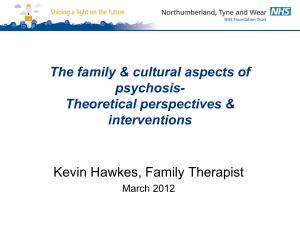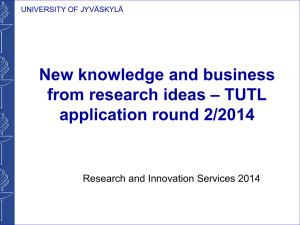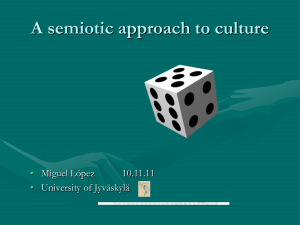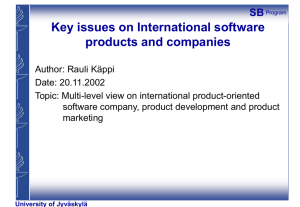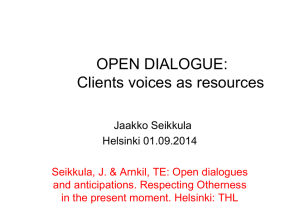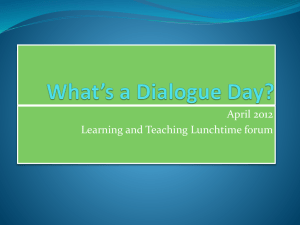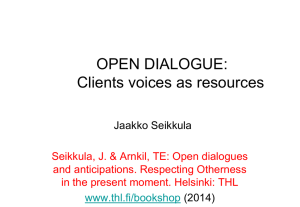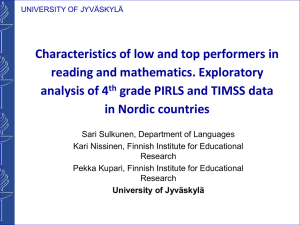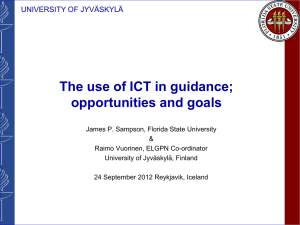PPT 164 Ko - European Family Therapy Association
advertisement
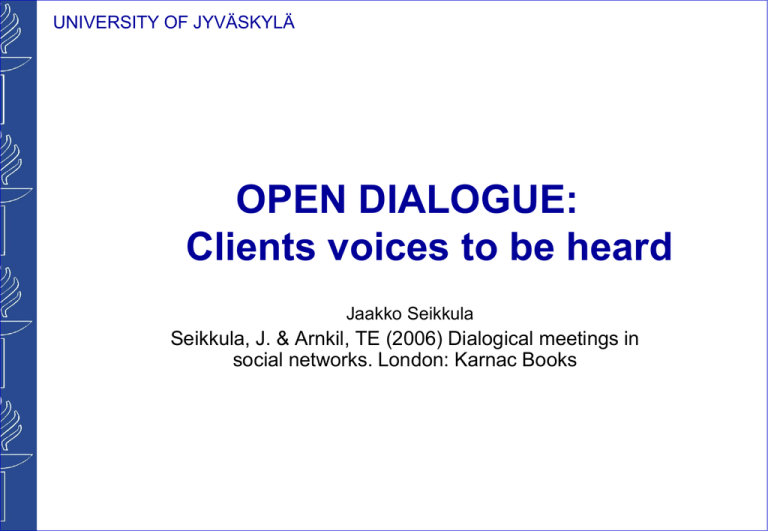
UNIVERSITY OF JYVÄSKYLÄ OPEN DIALOGUE: Clients voices to be heard Jaakko Seikkula Seikkula, J. & Arnkil, TE (2006) Dialogical meetings in social networks. London: Karnac Books UNIVERSITY OF JYVÄSKYLÄ DIALOGUE “For the word (and, consequently, for a human being) there is nothing more terrible than a lack of response” “Being heard as such is already a dialogic relation” (Bakhtin, 1975) UNIVERSITY OF JYVÄSKYLÄ The present moment To be present in the ”once occurring participation in being” (M.Bakhtin) ”Neither – nor” (T. Andersen) From explicit to implicit knowing (D. Stern, 2004) From narratives to telling Intersubjectivity: ”I see myself in your eyes” (M. Bakhtin) UNIVERSITY OF JYVÄSKYLÄ “ The conversational style (….) simply follows the conversation, while the narrative and solution-focused styles often attempt to lead it. The conversational style strives to remain dialogical, while the solution-focused and narrative styles may become monological (e.g., when therapists attempt to "story" clients' lives according to a planned agenda).” Lowe, R. (2005). Structured methods and striking moments: using question sequences in "living" ways. Family Process, 44, 65-75. UNIVERSITY OF JYVÄSKYLÄ Polyphonic self When the mind is thinking, it is simply talking to itself, asking questions and answering them, and saying yes or no. When it reaches a decision – which may come slowly or in sudden rush – when doubt is over and the two voices affirm the same thing, then we call that ’its judgement´. – Plato: Theatetus 189e-190a. UNIVERSITY OF JYVÄSKYLÄ “Voices are the speaking personality, the speaking consciousness”. (Bakhtin, 1984; Wertsch, 1990) “Voices are traces and they are activated by new events that are similar or related to the original event”. (Stiles et al., 2004) UNIVERSITY OF JYVÄSKYLÄ Mikko Sinikka T2 Seppo T1 Liisa ”Horizontal polyphony” = social relations UNIVERSITY OF JYVÄSKYLÄ Mikko Sinikka T2 Seppo T1 Family therapist mother father Liisa technician father female male memory of death ”Vertical polyphony” = inner voices son mother spouse daughter sister Father death UNIVERSITY OF JYVÄSKYLÄ Social networks Private social relations Collaboration across professional boundaries ”Horizontal polyphony” UNIVERSITY OF JYVÄSKYLÄ Origins of open dialogue Initiated in Finnish Western Lapland since early 1980’s Need-Adapted approach – Yrjö Alanen Integrating systemic family therapy and psychodynamic psychotherapy Treatment meeting 1984 Systematic analysis of the approach since 1988 – ”social action research” Systematic family therapy training for the entire staff – since 1989 UNIVERSITY OF JYVÄSKYLÄ MAIN ELEMENTS OF OPEN DIALOGUE MEETING Everyone participates from the outset in the meeting All things associated with analyzing the problems, planning the treatment and decision making are discussed openly and decided while everyone present Neither themes nor form of dialogue are planned in advance UNIVERSITY OF JYVÄSKYLÄ MAIN ELEMENTS OF OPEN DIALOGUE MEETING The primary aim in the meetings is not an intervention changing the family or the patient The aim is to build up a new joint language for those experiences, which do not yet have words UNIVERSITY OF JYVÄSKYLÄ MAIN ELEMENTS OF DIALOGUE MEETING/3 Meeting can be conducted by one therapist or the entire team can participate in interviewing Task for the facilitator(s) is to open the meeting with open questions; to guarantee voices becoming heard; to build up a place for reflective comments among the professionals; to conclude the meeting with definition of what have we done. UNIVERSITY OF JYVÄSKYLÄ MAIN ELEMENTS OF A DIALOGICAL MEETING/4 Professionals discuss openly of their own observations while the network is present There is no specific reflective team, but the reflective conversation is taking place by changing positions from interviewing to having a dialogue In the conversation the team tries to follow the words and language used by the network members instead of finding explanations behind the obvious behavior UNIVERSITY OF JYVÄSKYLÄ MAIN PRINCIPLES FOR ORGANIZING OPEN DIALOGUES IN SOCIAL NETWORKS IMMEDIATE HELP SOCIAL NETWORK PERSPECTIVE FLEXIBILITY AND MOBILITY RESPONSIBILITY PSYCHOLOGICAL CONTINUITY TOLERANCE OF UNCERTAINTY DIALOGICITY UNIVERSITY OF JYVÄSKYLÄ IMMEDIATE HELP First meeting in 24 hours Crisis service for 24 hours All participate from the outset Psychotic stories are discussed in open dialogue with everyone present The patient reaches something of the ”not-yet-said” UNIVERSITY OF JYVÄSKYLÄ SOCIAL NETWORK PERSPECTIVE Those who define the problem should be included into the treatment process A joint discussion and decision on who knows about the problem, who could help and who should be invited into the treatment meeting Family, relatives, friends, fellow workers and other authorities UNIVERSITY OF JYVÄSKYLÄ RESBONSIBILITY AND PSYCHOLOGICAL CONTINUITY The one who is first contacted is responsible for arranging the first meeting The team takes charge of the whole process regardless of the place of the treatment The meetings as often as needed The meetings for as long period as needed The same team both in the hospital and in the outpatient setting Not to refer to another place UNIVERSITY OF JYVÄSKYLÄ TOLERANCE OF UNCERTAINTY To build up a scene for a safe enough process To promote the psychological resources of the patient and those nearest him/her To avoid premature decisions and treatment plans To define open UNIVERSITY OF JYVÄSKYLÄ DIALOGICITY The emphasize in generating dialogue - not primarily in promoting change in the patient or in the family New words and joint language for the experiences, which do not yet have words or language “Listen to what the people say not to what they mean” UNIVERSITY OF JYVÄSKYLÄ “For each theme under discussion, every individual responds to a multiplicity of voices, internally and in relation to others in the room. All these voices are in dialogue with each other. Dialogue is a mutual act, and focusing on dialogue as a form of psychotherapy changes the position of the therapists, who acts no longer as interventionists, but as participants in a mutual process of uttering and responding”. Seikkula, J. & Trimble, D. (2005) Healing Elements of Therapeutic Conversation: Dialogue as an Embodiment of Love. Family Process 4/2005. UNIVERSITY OF JYVÄSKYLÄ 5 years follow-up of Open Dialogue in Acute psychosis Seikkula et al. Psychotherapy Research, March 2006: 16(2),214-228) 01.04.1992 – 31.03.1997 in Western Lapland, 72 000 inhabitants Starting as a part of a Finnish National Integrated Treatment of Acute Psychosis –project of Need Adapted treatment Naturalistic study – not a randomized trial Aim 1: To increase treatment outside hospital in home settings Aim 2: To increase knowledge of the place of medication – not to start neuroleptic drugs in the beginning of treatment but to focus on an active psychosocial treatment N = 90 at the outset; n=80 at 2 year; n= 76 at 5 years Follow-up interviews as learning forums UNIVERSITY OF JYVÄSKYLÄ OPEN DIALOGUE IN ACUTE PSYCHOSIS Table 1. Charasteristics of the patients at the baseline (N=80) Male Female Total --------------------------------------------Age (mean) 26.9 25.9 26.5 Employment status Studying 12 Working 27 Unemployed 7 Passive 4 Diagnosis (DSM-III-R) Brief psychotic episodes 12 Nonspecified psychosis 8 Schizophreniform psychosis 9 Schizophrenia 20 12 11 2 5 24 38 9 9 30 % 48 % 11 % 11 % 7 19 23 % 6 15 18 % 8 10 17 30 21 % 38 % UNIVERSITY OF JYVÄSKYLÄ OPEN DIALOGUE IN ACUTE PSYCHOSIS Figure 1. Means of hospital days at 2 and 5 years follow-ups 30 25 20 1.4.1992 31.3.1993 1.1.94-31.3.97 ODAP 15 10 5 0 0-2 years 2-5 years UNIVERSITY OF JYVÄSKYLÄ OPEN DIALOGUE IN ACUTE PSYCHOSIS Table 2. Psychotic symptoms at 5 year follow-up compared to neuroleptic medication during the first 2 years/ % Neuroleptics Not used Used or cont. Total Rating of symptoms 0 1 2 3 ------------------------------------85 9 3 3 58 17 8 17 ------------------------------------80 10 4 6 Chi-square 5.93; df=3; p=.145 (NS) 4 Total 0 0 100 100 0 100 UNIVERSITY OF JYVÄSKYLÄ OPEN DIALOGUE IN ACUTE PSYCHOSIS Table 3. Relapses compared to use of neuroleptics during the early phase of the treatment Neuroleptics Not-used Used Total/% Chi-sq. P -------------------------------------------------------Relapses 0-2 years 0 56 7 63/ 82 8.97;3 .030 At least 1 9 5 14/ 18 Relapses 2-5 years 0 At least 1 47 9 56/ 73 2.96;2 ns 16 3 19 27 ---------------------------------------------------------- Total number of relapsed cases 28% UNIVERSITY OF JYVÄSKYLÄ COMPARISON OF 5-YEARS FOLLOW-UPS IN WESTERN LAPLAND AND STOCKHOLM ODAP Western Lapland 1992-1997 N = 72 Diagnosis: Schizophrenia Other non-affective psychosis Mean age years female male Hospitalization days/mean Neuroleptic used - ongoing GAF at f-u Disability allowance or sick leave Stockholm* 1991-1992 N=71 59 % 54 % 41 % 46 % 26.5 27.5 30 29 31 33 % 17 % 66 110 93 % 75 % 55 19 % 62 % *Svedberg, B., Mesterton, A. & Cullberg, J. (2001). First-episode non-affective psychosis in a total urban population: a 5-year follow-up. Social Psychiatry, 36:332-337. UNIVERSITY OF JYVÄSKYLÄ TABLE 5 Psychological status of patients at the onset of the crisis in the Poor and Good outcome groups. Variable Poor outcome N=17 % Good outcome N=61 % Total N=78 % Duration of psychotic symptoms/months before contact - mean 7.6 2.5 - sd 7.6 4.1 3.6 5.3 *** Duration of prodromal symptoms/months before contact - mean 26.7 7.0 - sd 29.4 17.0 12.6 22.8 *** UNIVERSITY OF JYVÄSKYLÄ TABLE 6 Treatment variables of the Poor and Good outcome groups during the two-year follow-up period Poor Variable Hospitalization (days) - mean - sd Use of neuroleptic drugs Not used Ongoing or discontinued medication Good Total Outcome N=17 outcome N=61 N=78 47.5 56.0 9.0 19.2 18 36.3 47.1 80.3 73.1 52.9 19.7 28.9 *** *** UNIVERSITY OF JYVÄSKYLÄ Open dialogues with good and poor outcomes for psychotic crisis/ Jaakko Seikkula, 2002 /Journal of Marital and Family Therapy, 28(3):263 - 274 SUMMARY Good outcome Poor outcome Interactional dominance by clients 55-57% 10 – 35% Semantic dominance by clients 50-70% 40 -70% Symbolic language area in sequences 67 – 80% 0 – 20% Dialogical dialogue in sequences 60 – 65% 10 – 50% UNIVERSITY OF JYVÄSKYLÄ

